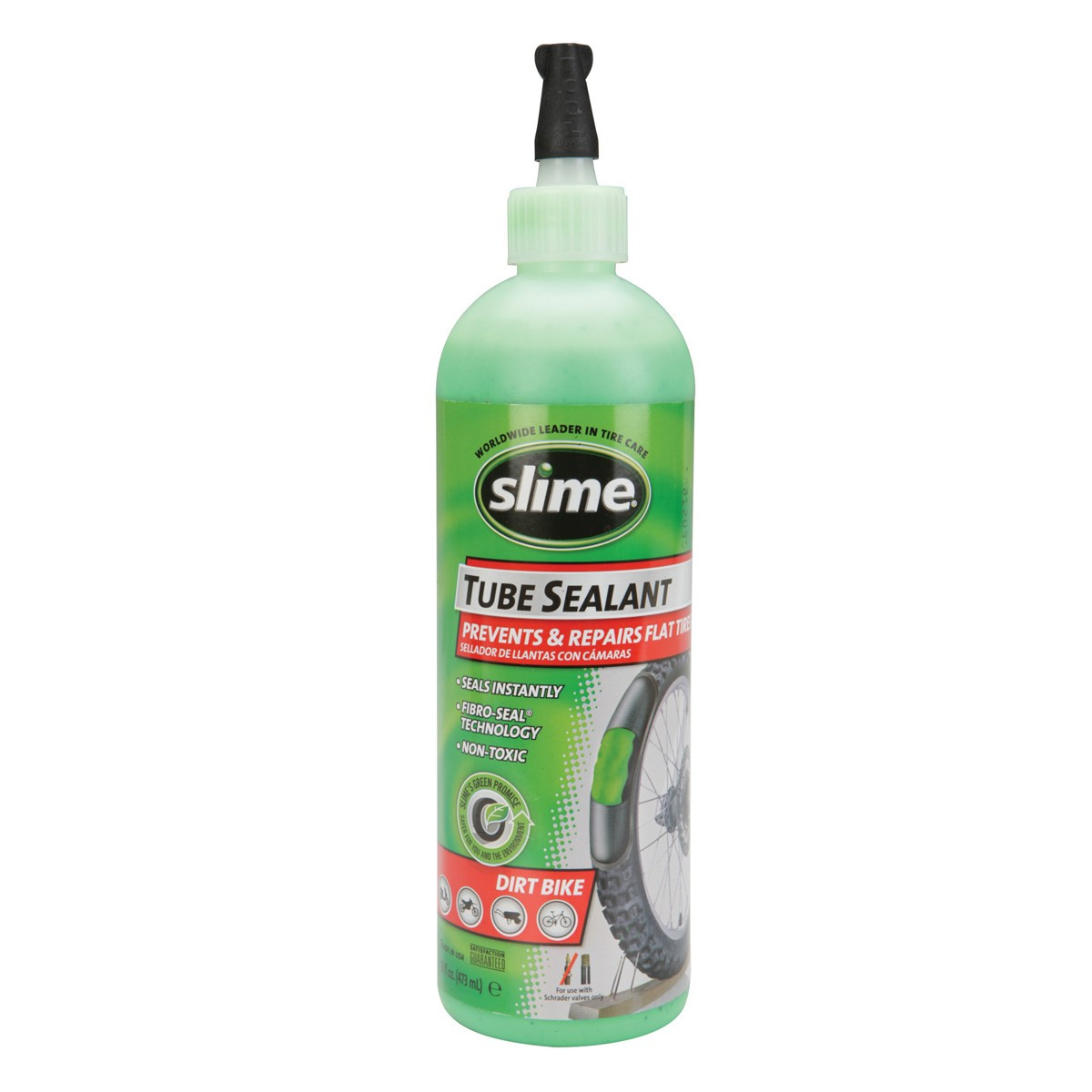Flat tires are a cyclist’s worst nightmare, capable of derailing even the most anticipated bike rides. In our quest to keep you rolling smoothly on usabikers.net, we’ve explored numerous solutions to avoid flats. One of the most effective, and often overlooked, is using a high-quality Bike Tire Sealant.
Bike tire sealants offer a proactive, almost magical, solution to punctures. Imagine injecting a liquid into your inner tube or tubeless tire that automatically seals punctures as they happen. That’s precisely what a bike tire sealant does. You simply introduce the sealant, reinflate your tire, and you’re ready to ride, often forgetting about flats altogether. The sealant evenly coats the inside of your tire, ready to spring into action the moment a puncture occurs. When a sharp object pierces your tire, the escaping air pressure forces the sealant into the hole, quickly creating a plug and preventing further air loss.
While not a foolproof 100% guarantee against every flat, bike tire sealant significantly reduces your chances of being sidelined by punctures. Having personally used various brands over the years, I can attest to their effectiveness in maintaining consistent rides. Different sealants have unique formulations, making some better suited for specific situations. Here, I’ll share reviews of three of my go-to bike tire sealants, helping you determine the best choice for your bicycle and riding style.
Bike Tire Sealant Review: Green Slime
 bottle of green slime bicycle tire sealant with valve removal tool cap
bottle of green slime bicycle tire sealant with valve removal tool cap
Green Slime stands out as a household name in tire sealants, recognized across various applications beyond just bicycles. From car tires to trailer tires and even ATVs, Green Slime has proven its versatility. Specifically for bicycle tubes, it’s a reliable and effective sealant.
Green Slime is characterized as a fibrous sealant. This means it contains a suspension of small fibers within the liquid. True to its name, its appearance is distinctly green and slimy. Conveniently, most Green Slime bottles include a valve core removal tool integrated into the cap. Installation is straightforward: use the cap tool to remove the valve core from your bicycle tube’s valve stem, inject the recommended amount of Green Slime, and then use the tool to reinstall the valve core. This process can be done with the tube already mounted on the bike or beforehand.
In my experience, Green Slime excels at sealing punctures caused by irregularly shaped objects like screws or wood splinters. Its fibrous nature seems particularly effective at plugging jagged holes. While this is based on observation, the fibrous composition likely contributes to creating a more robust seal in non-uniform punctures compared to some other sealants.
However, Green Slime’s primary drawback is its longevity as a fix. While it effectively seals punctures, my experience indicates that these seals tend to be temporary, lasting days rather than weeks or months. Green Slime functions more as a physical barrier. Therefore, consider Green Slime a temporary solution. If you spot Green Slime leaking from your tire and notice a foreign object embedded, it signals time to address the tire properly at home or a bike shop. Green Slime should provide enough hold to get you home safely, but it’s not intended for extended, continuous use after a puncture.
Bike Tire Sealant Review: Joe’s Super Sealant
Joe’s Super Sealant shares a similar installation method with Green Slime. However, it typically lacks the valve core removal tool, so you’ll need to source one separately if needed.
The fundamental difference lies in Joe’s Super Sealant’s composition. Unlike the fibrous nature of Green Slime, Joe’s sealant is more of a rubbery, glue-like substance. Upon air exposure, it hardens into a sticky, resilient compound – ideal for sealing punctures in bike tubes. (Though, be warned, it can be quite messy if it gets on your hands!)
This composition makes Joe’s Super Sealant particularly effective at sealing smaller, more uniform punctures. While larger, jagged punctures pose a challenge due to the extensive surface area, Joe’s excels at quickly filling and sealing smaller, cleaner holes with its glue-like action.
 bottle of joe's super sealant bike tire sealant with orange liquid
bottle of joe's super sealant bike tire sealant with orange liquid
My personal experience highlights Joe’s Super Sealant’s impressive longevity. Once, a thumbtack pierced my tire, and Joe’s sealant instantly sealed the puncture. Life got busy, and I delayed replacing the tube. Weeks turned into months, and to my surprise, the seal held perfectly. Curious about its limits, I continued riding. It wasn’t until eight months later, when a skid on wet pavement caused a crash, that the repair finally gave way. The crash’s force ejected the thumbtack, along with some sealant. Even then, the leak was gradual enough to allow me to ride the four miles home with slowly decreasing tire pressure. Considering the sealant was well over a year old at that point, and replacement is recommended every six months, its performance was exceptional. Regularly topping off the sealant every six months is a recommended practice to maintain optimal performance.
Bike Tire Sealant Review: Stan’s NoTubes Tire Sealant
 bottle of stans notubes tire sealant with white liquid
bottle of stans notubes tire sealant with white liquid
Stan’s NoTubes Tire Sealant is conceptually similar to Joe’s Tire Sealant, but it’s specifically formulated for tubeless bicycle tires. Tubeless systems, as the name suggests, eliminate the inner tube. Instead, the tire bead seals directly against the rim, creating an airtight chamber, much like a car tire.
Stan’s sealant shares the glue-type characteristic of Joe’s sealant. Both function by flowing into punctures and solidifying upon air exposure to create an airtight seal. For a visual demonstration of its effectiveness, check out Stan’s promotional videos – the puncture sealing is remarkably quick and effective!
Like Joe’s sealant, Stan’s NoTubes Tire Sealant requires periodic replenishment to prevent drying out inside the tire. A six-month interval for topping off is generally recommended. While designed for tubeless systems, Stan’s NoTubes Tire Sealant works equally well within inner tubes, providing the same puncture-sealing benefits.
Bike Tire Sealants: The Final Verdict
Bike tire sealants are indispensable for any cyclist seeking to minimize flat tire frustrations – which is essentially every cyclist. All three sealants discussed – Green Slime, Joe’s Super Sealant, and Stan’s NoTubes – are effective solutions. Personally, I lean towards Joe’s Super Sealant, primarily due to my extensive positive experiences with its performance and longevity.
Ultimately, any of these three sealants will significantly enhance your ride experience and increase your chances of reaching home even after encountering a puncture mid-ride. Green Slime serves as a more temporary fix, while Joe’s and Stan’s offer more enduring solutions. In a pinch, tire sealant can even be used to repair a flat tire on the spot, negating the immediate need for wheel removal and tube replacement. Simply inject sealant into the flat tire, reinflate, and there’s a good chance the puncture will seal, getting you back on your way.
While no system guarantees 100% flat prevention, bike tire sealant is arguably the most practical and effective measure available, short of resorting to specialized foam tires or other radical flat-prevention technologies.
 bottle of joe's super sealant bike tire sealant on a bicycle tire
bottle of joe's super sealant bike tire sealant on a bicycle tire

